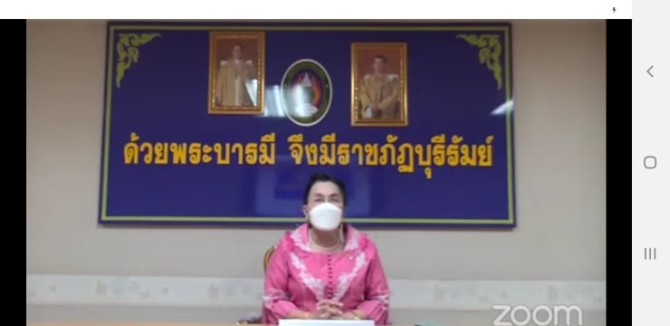
ผู้วิจัย
sombat prajonsant
บทคัดย่อ
Khmer Sanctuaries in the lower part of the northeastern region of Thailand are an integral part of cultural heritage of Khmer civilization. The graphic pattern of floor plan is architectural representation, which is a universal language. However, the floor plans of Khmer sanctuaries have never been made into the designs of Mudmee or Ikat silk before. Thus, this project was aimed at creating graphic designs of Mudmee silk based on the inspirations from floor plans of Khmer sanctuary in the lower part of the Northeast of Thailand. As an experiment, local artisans were asked to produce Mudmee silk and two prototypes were created. Academic information was given to support the design, which made use of a number of processes, namely simplification, composition, and color scheme, in combination with creative Mudmee techniques derived from local wisdoms. The artisans had to apply their body of knowledge from preparation of silk threads to calculation of the numbers of warps and wefts, bleaching, dyeing, creation of Mudmee designs, and Mudmee weaving technique. It was suggested that other techniques should be applied to Mudmee silk in order to improve dimensions of the designs by using the different values of colors or combining other inspirations with Khmer temple floor plans. This would enable the artisans to develop a wide variety of designs. Certain symbols could be further represented by abstract images.
บรรณานุกรม
Department of Industrial Promotion, The Industry Sector Development Bureau, Textile Industry Section. (2003). Mudmee in a New Perspective. Bangkok: Process Color Designs and Printing. Janpala, J. et al., (2013). “Pattern Development of Thai Songdam Woven Fabrics for Value Addition under the Creative Economy Principle.” In Meeting documents at the 3rd National Culture Conference, Ministry of Culture,. pp.207-226. Leuchutakul, M. (2006). Factors Affecting the Decisions to Buy One Tambol One Product Silk Products of Consumers in Nakhon Ratchasima Province. Nakhon Ratchasima: Nakhon Ratchasima Rajabaht University. Queen Sirikit Sericulture Center, Chiang Mai. (2012). Research Project for Preparation of Guideline for Production of Silk Fabrics and Products Meeting the Needs of Customers in Thailand. [online URL: http:// www.qsda.go.th/]. Accessed on March 28, 2012. Sikkha, S. (2011). Creation of Unique Woven Fabric Patterns of Isan. Industrial Technology Journal of Ubon Ratchathani Rajabaht University (1, 2), : 119-132. Pakdeesuwan, S. (2009). Mudmee Silk Designs of Maha Sarakham Province in A Contemporary Context. Master Thesis.(Media Arts and Design Program), Chiang Mai University, Chiang Mai, Thailand Prajonsant, S. et al., (2003). Research Report on Development of Local Wisdom Database: A Case Study of Well-Known Local Woven Fabric Products by Ethnic Groups in Buriram Province. Buriram: Buriram Rajabhat University. Prajonsant, S. et al., (2004). Participatory Research Report on Development of Community-Level Standards of Local Woven Fabrics in the Northeast of Thailand: A Case Study of Mudmee Silk of the Weaver Groups in the Northeast of Thailand. Buriram: Buriram Rajabhat University. Prajonsant, S. (2011). Research Report on Development of Pattern Prototypes of 2-Dimension Graphic design from Patterns of Decorative Motifs of Khmer Sanctuary in Buriram Province. Buriram: Buriram Rajabhat University. Prajonsant, S. (2012). Research Report on Development of Local Woven Fabric Patterns based on 2-Dimension Graphic design from Decorative Motifs of Khmer Sanctuary in Buriram Province. Buriram: Buriram Rajabhat University.
หน่วยงานการอ้างอิง
Silpakorn University Journal of Social Sciences, Humanities, and Arts Vol.15(3) : 115 - 132, 2016









ความคิดเห็น